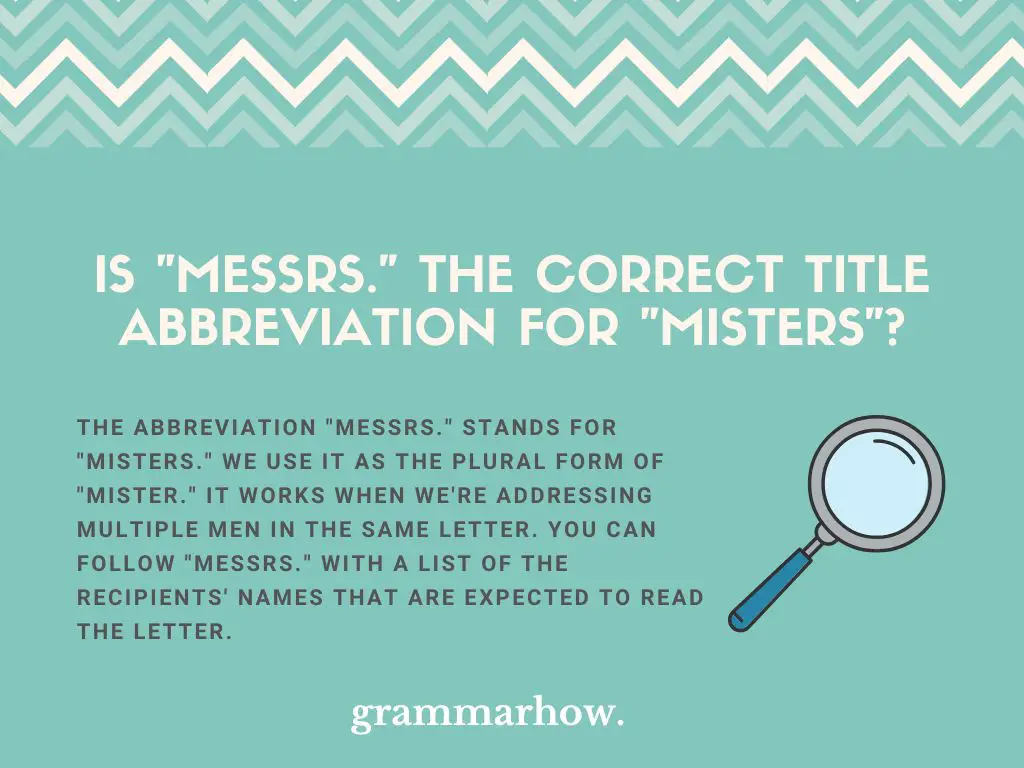Addressing multiple people in a letter can come up with a confusing abbreviation. This article will explore how “Messrs.” applies in letter contexts and what you need to know to make sure you’re using it correctly.
Is “Messrs.” The Correct Title Abbreviation For “Misters”?
The abbreviation “Messrs.” stands for “Misters.” We use it as the plural form of “Mister.” It works when we’re addressing multiple men in the same letter. You can follow “Messrs.” with a list of the recipients’ names that are expected to read the letter.

So, why is it spelled in such a strange way? Why can’t we just use “Mr.’s” as the abbreviation?
“Messrs.” comes from the French plural form “messieurs.”
The correct format would look like this:
- Dear Messrs. Johnson, Wright, and Tarnation,
As you can see, it’s much more efficient to be able to group the men we’re referring to in our letter. If there wasn’t a plural form for “Mister,” we might end up with something like this:
- Dear Mr. Johnson, Mr. Wright, and Mr. Tarnation,
This is much messier. It does not show that we’ve understood the plural idea of “Mister,” and many people would be put off reading your letter before they’ve even started.
What Is The Plural Of “Mrs.”?
The plural of “Mrs.” is “Mmes.” Again, this comes from the French root word of “mesdames.” We use this whenever we’re addressing multiple women with the same letter contents. It makes sense because it allows us to group them all up.
The correct format we use here is:
- Dear Mmes. Morrison and Smythe,
Again, we use the plural form here to make our introduction clearer and more succinct. It helps us to remove multiple instances of “Mrs.”
The only issue that might arise is if you don’t know whether one of the women you’re sending your letter to is a “Mrs.” If they are not married, they might not want to be referred to in this way, so “Mmes.” isn’t your best bet.
What Is The Plural Of “Ms.”?
Some women like to use “Ms.” as their title. It’s possible to use the plural form of “Ms.,” which is either “Mses.” or “Mss.” Both forms are correct, and both indicate that you’re unsure about the direct title that the women you’re sending your letter to hold.
Since there are two different variations, we’ll refer to them both below:
- Dear Mses. Exmouth, Sarah, and Peterson,
- Dear Mss. Thomas, Redford, and Lampard
As you can see, the only difference comes from choice. The extra “E” in “Mses.” isn’t a mistake, and most people will be fine regardless of how you write it.
Also, if you’re unsure about someone’s title, it’s usually better to stick to “Mss.” or “Mses.” to be a bit more respectful. It’s better to assume someone is not married and use “Ms.” rather than assuming they are by using “Mrs.”
Proper Title Abbreviation For Mixed Genders
We’ve run you through all the ways to refer to multiple people in letters. However, each case we’ve referred to has only mentioned one gender. What happens when you have to send a letter to multiple men and women?
If you’re sending a letter to one man and one woman, there is no plural form needed. Instead, you use “Mr.” and either “Mrs.” or “Ms.” If you’re sending to multiple people from both genders, you should distinguish the clear difference between genders (i.e. “Messrs. and Mses.”)
To help you understand it, you can refer to the following examples.
One man and one woman:
- Dear Mr. Smith and Mrs. Hyde,
Two men and one woman:
- Dear Messrs. Smith and Jackon, and Mrs. Walters,
One man and two women:
- Dear Mr. Peach and Mses. Wise and Blue,
Multiple of both genders:
- Dear Messrs. Jones and Bloggs, and Mses. Jones and Steward
It’s rare to refer to that many people all in the same letter, but it’s still correct to follow these rules when doing so.
Is It Appropriate To Use The Plural Abbreviation For Mr., Mrs., And Ms. In A Formal Letter?
All of these plural abbreviations are appropriate for formal letters. In fact, formal letters are going to be the most likely place where you will use these forms since you’re more likely to refer to multiple people by their titles rather than their names.
You may also like: Plural Of “Sir” – Full Explanation (With Examples)

Martin holds a Master’s degree in Finance and International Business. He has six years of experience in professional communication with clients, executives, and colleagues. Furthermore, he has teaching experience from Aarhus University. Martin has been featured as an expert in communication and teaching on Forbes and Shopify. Read more about Martin here.
